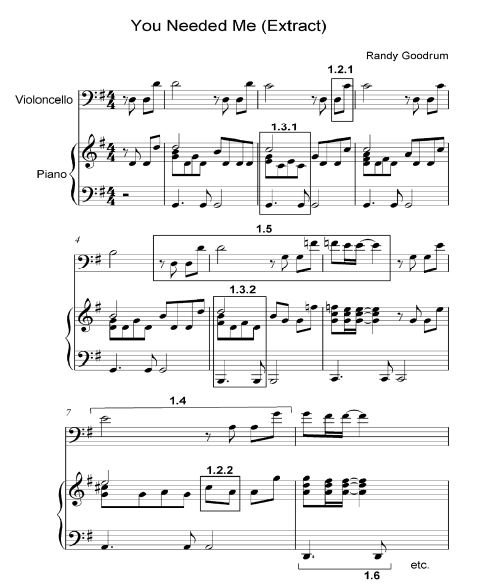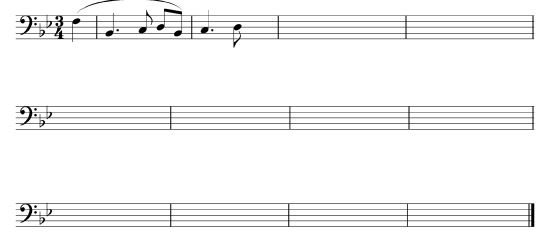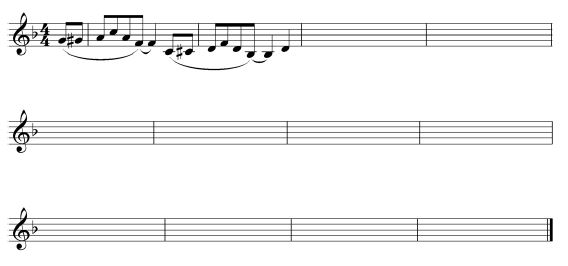MUSIC PAPER 1 GRADE 12 QUESTIONS - NSC PAST PAPERS AND MEMOS NOVEMBER 2016
Share via Whatsapp Join our WhatsApp Group Join our Telegram GroupMUSIC
PAPER 1
GRADE 12
NSC PAST PAPERS AND MEMOS
NOVEMBER 2016
INSTRUCTIONS AND INFORMATION
- This question paper consists of FIVE sections, namely SECTIONS A, B, C, D and E.
- SECTIONS A and B are COMPULSORY.
- SECTION C: WESTERN ART MUSIC (WAM), SECTION D: JAZZ and SECTION E: INDIGENOUS AFRICAN MUSIC (IAM) are choice questions. Answer only ONE of these sections (SECTION C or D or E).
- Write all music notation in SECTION A in pencil and all written text in blue or black ink on this question paper.
- Answer SECTION B and SECTION C or D or E in blue or black ink in the ANSWER BOOK provided.
- Number the answers correctly according to the numbering system used in this question paper.
- The last page of this question paper is manuscript paper intended for rough work. Candidates may remove this page.
- Candidates may NOT have access to any musical instrument for the duration of this examination.
- Candidates must take note of the mark allocation for each question to provide enough information in their answers.
- Write neatly and legibly.
MARKING GRID
SECTION | QUESTION | MARKS | MARKER | MODERATOR |
A: THEORY OF MUSIC (COMPULSORY) | 1 | 20 | ||
2 | 15 | |||
3 | 10 | |||
4 | 15 | |||
SUBTOTAL | 60 |
AND
| B: GENERAL MUSIC KNOWLEDGE (COMPULSORY) | 5 | 20 | ||
| SUB-TOTAL | 20 | |||
AND
| C: WAM | 6 | 10 | ||
7 | 5 | |||
8 | 5 | |||
9 | 5 | |||
10 | 15 | |||
SUBTOTAL | 40 |
OR
| D: JAZZ | 11 | 10 | ||
12 | 5 | |||
13 | 5 | |||
14 | 5 | |||
15 | 15 | |||
SUBTOTAL | 40 |
OR
| E: IAM | 16 | 10 | ||
17 | 5 | |||
18 | 5 | |||
19 | 5 | |||
20 | 15 | |||
SUBTOTAL | 40 |
| GRAND TOTAL | 120 |
QUESTIONS
SECTION A: THEORY OF MUSIC (COMPULSORY) (90 minutes)
Answer QUESTION 1
AND QUESTION 2.1 OR 2.2
AND QUESTION 3.1 OR 3.2
AND QUESTION 4.1 OR 4.2.
Answer the questions in the spaces provided on this question paper.
QUESTION 1 (25 minutes)
Study the extract below and answer the questions that follow.
1.1 Name the main key of this piece. ____________________________________________ (1)
1.2 Name the intervals at 1.2.1 and 1.2.2 according to type and distance.
1.2.1 ______________________________________
1.2.2 ______________________________________ (2)
1.3 Name the triads at 1.3.1 and 1.3.2 according to type and position/inversion.
1.3.1 ______________________________________
1.3.2 ______________________________________ (2)
1.4 Rewrite the violoncello part of bar 7 in compound time. Add the new time signature.
(3)
1.5 Transpose the violoncello part of bars 43–62 a tone (major second) higher. Insert the new key signature.

1.6 Rewrite the bass part of the piano in bar 8 TWO octaves higher in the alto clef.(1)
1.7 Complete the melodic fragment below by adding TWO ascending sequences.
1.8 Write the scales below as indicated.
1.8.1 Complete the ascending chromatic scale starting on the given note. 
1.8.2 Complete the ascending Dorian mode starting on E. (2)
1.8.3 Write Bb melodic minor ascending and descending with key signature. Mark the semitones.
(2)
[20]
QUESTION 2 (25 minutes)
Answer EITHER QUESTION 2.1 OR QUESTION 2.2.
2.1 Complete the opening motif below to form a twelve-bar melody in ternary form for any single-line melodic instrument of your choice. Name the instrument for which you are writing. Indicate the tempo and add dynamic and articulation marks.
Instrument: _________________________
Tempo: _________________________
The melody will be marked according to the following criteria:
DESCRIPTION | MARK ALLOCATION | CANDIDATE'S MARKS |
Form and cadential points | 3 | |
Correctness | 2 | |
Quality | 10 | |
TOTAL | 15 |
[15]
OR
2.2 Complete the opening motif below to form a twelve-bar melody in ternary form for any single-line melodic instrument of your choice. Name the instrument for which you are writing. Indicate the tempo and add dynamic and articulation marks.
Instrument: ________________________
Tempo: _________________________
The melody will be marked according to the following criteria:
DESCRIPTION | MARK ALLOCATION | CANDIDATE'S MARKS |
Form and cadential points | 3 | |
Correctness | 2 | |
Quality | 10 | |
TOTAL | 15 |
[15]
QUESTION 3 (10 minutes)
Answer EITHER QUESTION 3.1 OR QUESTION 3.2.
3.1 Study the extract from Mozart's Sonata K.283 below and answer the questions that follow.
3.1.1 Name the key of this extract. __________________________________________ (1)
3.1.2 Identify chords (a) to (e) and figure them on the score. Use EITHER figuring below the score, for example V6, OR chord symbols, for example B/D# above the score. (5)
3.1.3 Name the cadence in bars 3–4. ___________________________________________ (1)
3.1.4 Name the type of non-chordal note at (i). ____________________________________________ (1)
3.1.5 Circle ALL the passing notes on the score that occur in bar 8 on beats 1 and 2. (2) [10]
OR
3.2 Study the extract from Solitaire by Neil Sedaka and Philip Cody below and answer the questions that follow.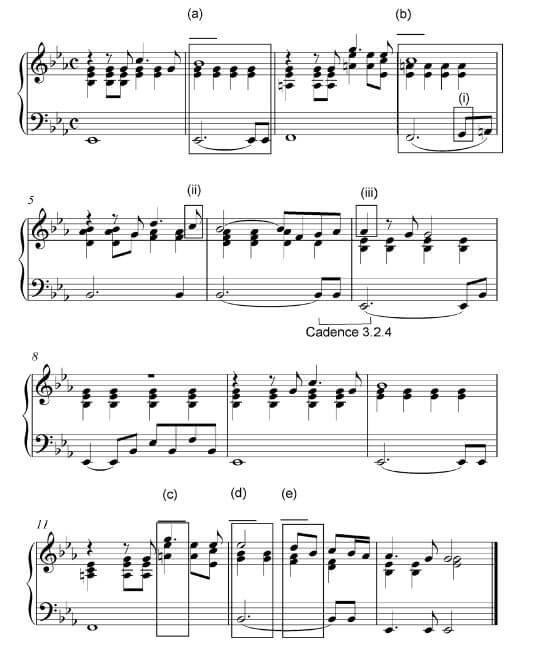
3.2.1 Name the key of this extract. ________________________________________________ (1)
3.2.2 Identify chords (a) to (e) and figure them on the score. Use chord symbols above the score, for example Bb/D. (5)
3.2.3 Name the type of non-chordal notes at (i) to (iii).
- _________________________________________________
- _________________________________________________
- _________________________________________________ (3)
3.2.4 Name the cadence in bars 6–7. ________________________________________________ (1) [10]
QUESTION 4 (30 minutes)
Answer EITHER QUESTION 4.1 OR QUESTION 4.2.
4.1 Complete the four-part vocal harmonisation below by adding the alto, tenor and bass parts. 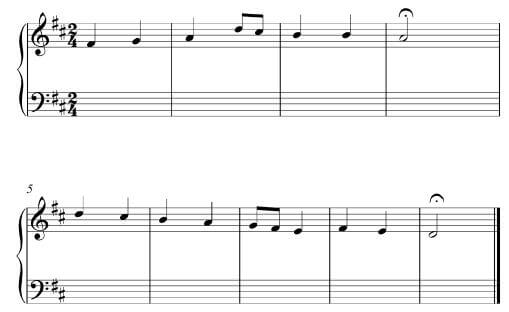
The harmonisation will be marked according to the following criteria:
DESCRIPTION | MARK ALLOCATION | CANDIDATE'S MARKS |
Chord progression | 14 | |
Correctness | 16 | |
Quality | 10 | |
40 (÷ 8 x 3) | ||
TOTAL | 15 |
[15]
OR
4.2 Complete the piece below by adding a suitable bass line and harmonic material in the open staves. Continue in the style suggested by the given material in bars 1–3.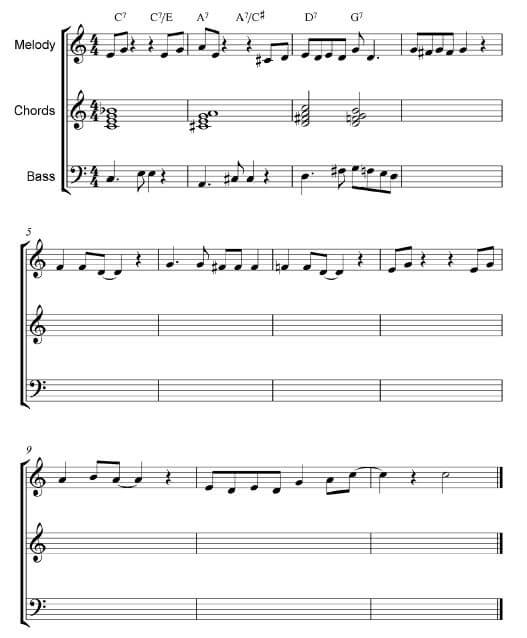
The answer will be marked according to the following criteria:
DESCRIPTION | MARK ALLOCATION | CANDIDATE'S MARKS |
Chord progression | 15 | |
Correctness | 15 | |
Quality | 10 | |
40 (÷ 8 x 3) | ||
TOTAL | 15 |
[15]
TOTAL SECTION A: 60
SECTIONS B, C, D, E: GENERAL MUSIC KNOWLEDGE (90 minutes)
Answer SECTION B
AND SECTION C (Western Art Music)
OR SECTION D (Jazz)
OR SECTION E (Indigenous African Music).
Answer these questions in the ANSWER BOOK provided.
SECTION B: GENERAL (COMPULSORY)
QUESTION 5
5.1 Various options are provided as possible answers to the following questions. Write down the question number (5.1.1–5.1.10), choose the answer and make a cross (X) over the letter (A–D) of your choice in the ANSWER BOOK.
EXAMPLE:
5.1.11 ![]()
5.1.1 Presto is the ...
- German word for fast.
- Italian word for fast.
- Italian word for lively.
- German word for lively.
5.1.2 The term falsetto refers to a ...
- female voice singing fast runs and melismas.
- woodwind instrument playing high-pitched notes.
- male voice singing in the female voice range.
- woodwind instrument playing out of tune.
5.1.3 A chordophone is any instrument ...
- that produces sound generated by a stretched string.
- where the sound is generated by its own material.
- of which the sound is generated by a membrane.
- on which chords can be played.
5.1.4 Which term below describes the repetition of a melody or idea at a different pitch?
- Augmentation
- Diminution
- Inversion
- Sequence
5.1.5 Which ONE of the following terms is NOT a texture type?
- Monophonic
- Polyphonic
- Stereophonic
- Homophonic
5.1.6 To which ONE of the following does binary term refer?
- AB
- ABACA
- ABA
- ABCBA
5.1.7 Which ONE of the statements below is CORRECT about transposing instruments?
- A flute sounds an octave higher than the written part.
- A double bass sounds an octave lower than the written part.
- A guitar sounds an octave higher than the written part.
- A trumpet sounds a major third lower than the written part.
5.1.8 Which ONE of the following is a woodwind instrument?
- Euphonium
- Cor anglais (English horn)
- Trumpet
- French horn
5.1.9 Tempo giusto means ...
- a free tempo.
- a lively tempo.
- increasing the tempo instantly.
- strict tempo.
5.1.10 ![]() The little note must be played ...
The little note must be played ...
- with extra force.
- according to the player's choice.
- as quickly as possible.
- with half the value of the note that follows it. (10 x 1) (10)
5.2 Briefly describe the functions of SAMRO. (4)
5.3 Copyright gives the copyright owner exclusive rights regarding the use of his/her music. Elaborate on this statement. (4)
5.4 Define the following terms:
5.4.1 Needletime rights royalties (1)
5.4.2 Mechanical rights royalties (1)
TOTAL SECTION B: 20
Answer SECTION C (WAM)
OR SECTION D (JAZZ)
OR SECTION E (IAM).
SECTION C: WESTERN ART MUSIC (WAM)
QUESTION 6
6.1 Describe the following terms with regard to form:
6.1.1 Minuet and trio (2)
6.1.2 Rondo (2)
6.1.3 Development (2)
6.1.4 First subject/theme (2)
6.2 A symphonic poem is based on programmatic content. Explain the meaning of this statement. (2) [10]
QUESTION 7
Discuss the importance of the Mannheim orchestra. [5]
QUESTION 8
Write a paragraph in which you define the genre of Mendelssohn's Hebrides Overture. Briefly describe the form of the work and discuss the importance of the title. [5]
QUESTION 9
Study the extract below from the Pastoral Symphony by Beethoven. Write a paragraph on the movement in which the extract occurs. [5]
QUESTION 10
Mozart perfected the aria as a genre in his opera The Magic Flute.
Elaborate on this statement. Define the aria as a genre and discuss TWO arias sung by different characters in The Magic Flute.
You will be credited for the logical presentation of facts and the structure of your essay. The essay will be marked according to the following criteria:
CRITERIA | MARK ALLOCATION |
Definition of an aria | 2 |
Aria 1 | 5 |
Aria 2 | 5 |
Logical presentation and structure of the essay | 3 |
TOTAL | 15 |
[15]
TOTAL SECTION C: 40
OR
SECTION D: JAZZ
QUESTION 11
11.1 Choose the jazz classification from COLUMN B that matches the artist/group in COLUMN A. Write only the letter (A–F) next to the question number (11.1.1–11.1.6) in the ANSWER BOOK, for example 11.1.7 G.
COLUMN A | COLUMN B |
11.1.1 The Flying Jazz Queens 11.1.2 Lemmy Mabaso 11.1.3 Makgonatsohle Band 11.1.4 Voice 11.1.5 Dollar Brand 11.1.6 Union of South Africa | A modern jazz B mbaqanga C kwela D Cape jazz E marabi F jazz in exile |
(6 x 1) (6)
11.2 Name ONE important contribution to South African jazz made by EACH of the following artists:
11.2.1 Zim Nqawana (1)
11.2.2 The Jazz Epistles (1)
11.2.3 Miriam Makeba (1)
11.2.4 Chris MacGregor (1) [10]
QUESTION 12
Write a paragraph in which you describe kwela. Also briefly explain its role in the development of South African jazz. [5]
QUESTION 13
Describe the mbaqanga style found in the music of bands such as Makgonatsohle Band, The Cool Crooners or Soul Brothers. [5]
QUESTION 14
Discuss the origin and style characteristics of marabi music. Refer to at least ONE artist or group. [5]
QUESTION 15
Write an essay on the music of ONE of the following Cape jazz artists:
- Abdullah Ibrahim
- Robbie Jansen
- Winston Mankunku Ngozi
You will be credited for the logical presentation of facts and the structure of your essay.
The essay will be marked according to the following criteria:
CRITERIA | MARK ALLOCATION |
Music characteristics | 5 |
Origins and influences | 5 |
Albums/Songs | 2 |
Logical presentation and structure of the essay | 3 |
TOTAL | 15 |
[15]
TOTAL SECTION D: 40
OR
SECTION E: INDIGENOUS AFRICAN MUSIC (IAM)
QUESTION 16
16.1 Give a term to describe EACH of the following:
16.1.1 A style of music that includes light dance-like walking on one's toes (1)
16.1.2 The rapid instrumental introduction to a maskandi song (1)
16.2 Choose the item in COLUMN B that matches the artist/group in COLUMN A. Write only the letter (A–E) next to the question number (16.2.1–16.2.5) in the ANSWER BOOK, for example 16.2.6 F.
COLUMN A | COLUMN B |
16.2.1 Abbey Cindi 16.2.2 Phuzekhemisi 16.2.3 Soul Brothers 16.2.4 Sello Galane 16.2.5 Isicathamiya | A mbaqanga B flute C SATB/TTBB D maskandi E moropa wa diatla |
(5 x 1) (5)
16.3 Briefly describe the role of music in traditional African religion. (3) [10]
QUESTION 17
Discuss local and international influences in malombo music. Refer to at least ONE artist or group. [5]
QUESTION 18
Describe the mbaqanga style found in the music of bands such as Makgonatsohle Band, The Cool Crooners or Soul Brothers. [5]
QUESTION 19
Discuss isicathamiya music with regard to its characteristics and how this style gained international status. [5]
QUESTION 20
Maskandi is traditionally a Zulu music style which features prominently in today's popular music.
Write an essay in which you expand on this statement by discussing the origins and characteristics of the style.
You will be credited for the logical presentation of facts and the structure of your essay. The essay will be marked according to the following criteria:
CRITERIA | MARK ALLOCATION |
Origins | 4 |
Style characteristics | 6 |
Artist and song | 2 |
Logical presentation and structure of the essay | 3 |
TOTAL | 15 |
[15]
TOTAL SECTION E: 40
GRAND TOTAL: 120
